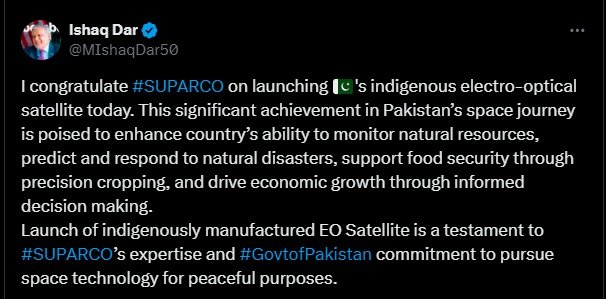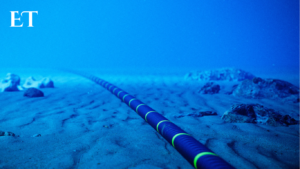On January 17, Pakistan launched its first native Electro-Optical Satellite EO-1, from the Jiuquan Satellite Launch Centre, which is operated by the China National Space Administration. This EO-1 Satellite uses electro-optical sensors to gather information and images of the Earth’s Surface by detecting and measuring the emitted radiation or sunlight. Suparco said that the PRSC-EO-1 satellite helps Pakistan monitor natural resources and improve urban planning and agricultural development. It will boost Pakistan’s ability to develop agriculture and respond to disasters. The agency said, “This major achievement marks a massive step in Pakistan’s journey of self-reliance and technological excellence in space exploration.”
Chairman of Suparco Muhammad Yousaf Khan expressed gratitude for the Government’s “firm support” and appreciated the hard work and dedication of agency engineers. He highlighted that the launch reflected “Pakistan’s commitment to benefit from Space technology for national progress and legitimate development.”
Read Also: Will India Visit Pakistan For ICC Champions Trophy is Still a Mystery
Suparco said this satellite offered valuable perception across diverse sectors in the following ways: Agriculture, Urban planning, Environmental management, and Disaster management, and also assists in monitoring natural resources like oil, gas, and minerals reserves.
Agriculture: EO-1 supports precision farming, irrigation management, and crop yield forecasting.
Urban Planning: Helping in monitoring infrastructure growth and managing rapid urbanization.
Environmental Management: tracking deforestation, glacier recession, and water resources.
Disaster Management: Delivering timely updates on floods, landslides, and earthquakes for effective responses.
In addition to this, Suparco also said that Satellite EO-1 also assists in monitoring and conserving natural resources like oil, minerals, and gas. Moreover, These abilities make the EO-1 satellite an important tool for legitimate development and informed decision-making. The agency said, “The successful launch of Satellite EO-1 represents a pivotal step in Pakistan’s journey toward Space Technology excellence and strengthens Sparco’s role as a leading figure in the nation’s socioeconomic growth through inventive space solutions” China Aerospace Science and Technology Corporation said in a statement, that China’s Long March-2D carrier rocket also launched two more rockets on the same day Tianlu-1 and Blue Carbon 1 with Pakistan’s PRSC-EO-1 satellite into orbit.
Read Also: Google Pay will be Launching in Pakistan in March 2025
Pakistan’s Prime Minister Shehbaz Sharif said in a statement, that Led by Sparco, This illustrates our Nation’s growing abilities in space science and technology. He said it was a “Proud Moment” for whole nation. Deputy Prime Minister and Foreign Minister Ishaq Dar called the successful launch a “remarkable achievement” in the journey of Space.

He said in a post on X, “Launch of Native manufactured EO-1 satellite is evidence to Suparco’s expertise and government of Pakistan’s dedication to pursuing space technology for peaceful purposes”. The Inter-Services Public Relations showered it as a “significant milestone”. In addition to this, This achievement is set to position advanced space technology abilities to the spearhead of Pakistan’s national progress and development, lining up with the goals of the National Space Policy. Last year in May, Pakistan launched a multi-mission communication satellite, PakSat-MM1 to make better internet and communication infrastructure. It was developed in partnership with Sparco and the Great China Wall corporation.
Moreover, Suparco also connected with a lunar exploration mission in November by participating in China’s Chang’e 8 mission, which is set to launch in 2028. Currently, it’s valued at 5 billion $, and the Earth observation satellite is among the fastest-growing zones within the commercial space industry, With NovaSpace forecasting it to exceed 8 billion $ by 2033.










